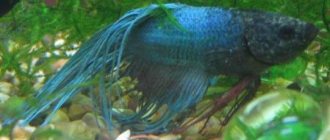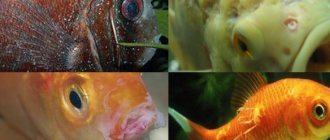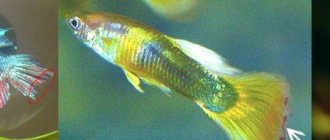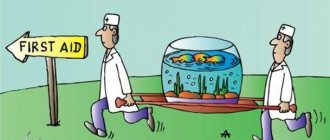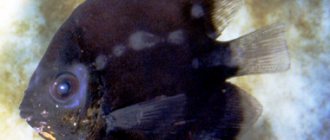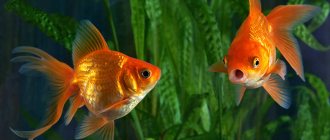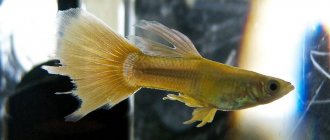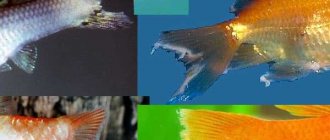4.9 (18)
Experienced aquarists know how important it is to keep the nursery clean, do timely water changes and check the levels of nitrates and phosphates. However, beginners often bypass these recommendations, which leads to various diseases.
Protruding eyes in fish (scientific name is exophthalmia) is a consequence of an infectious or fungal infection or keeping a pet in an inappropriate toxic environment. All types of fish are susceptible to it, since bulging eyes are not considered a separate type of disease, but only a cause of poor care.
This pathology affects the eyes of fish. Liquid accumulates inside or behind them, causing the apple to swell in size and literally fall out of its “orbits.” The entire visible surface of the eye becomes cloudy. If timely treatment is not taken, the fish may lose an eye, because over time the affected organ is completely separated from the body.
Despite the fact that the disease manifests itself as eye problems, it primarily affects the functioning of the kidneys and liver. An organism poisoned by environmental toxins is no longer able to cleanse itself, and kidney failure occurs in fish, which leads to similar consequences.
Fin diseases
It is sometimes quite difficult to figure out what fish suffer from, but fin diseases become obvious quickly and if appropriate measures are taken, they can be easily treated.
Fin Compression
Symptoms: fins and/or tail compressed horizontally.
Reasons: monotonous or poor nutrition during growing up.
Treatment: adding 1g of table salt per 1 liter of water to the aquarium.
Fin split
Symptoms: rupture-splitting of the fin, most often the tail.
Causes: injury, sudden change in water parameters, lack of vitamin D.
Treatment: adding iodine to the aquarium in a ratio of 0.1 ml:1 liter of water.
Tail fraying
Symptoms: The edge of the tail appears unnaturally uneven, as if frayed or torn.
Reasons: overpopulation of the aquarium, predatory or overly playful bully neighbors, rare water changes.
Treatment: first of all, eliminate the cause of the disease. And in order for the males to please you again with neat tails, the torn edge can be cut off using a sharp razor; during this operation, cotton wool soaked in aquarium water is placed on the gills of the fish.
Fin rot
Fin rot is one of the most common diseases among all breeds of aquarium fish.
Symptoms: ulcers on the body of the fish (most often, of course, on the fins); swollen abdomen; bluish-white cloudiness - a border along the edge of the fins, which gradually grows; spots and red stripes on the fins, white ulcers with discharge of pus.
Causes: injuries (for example, due to aggression from other inhabitants of the aquarium), frequent stress, dirty water. Bacteria groups: Aeromonas, Flexibacter, Pseudomonas, Vibrio. Which can get into an aquarium with uncleaned decorations, soil, and plants from natural bodies of water.
Attention! Do not confuse with alkaline disease! With this disease, the fins become smaller, as if disappearing at the edges, but are not completely destroyed, but become smaller. Alkaline disease occurs due to high pH levels. In order to restore the health of the fish, you need to gradually change the pH level.
Treatment: if you do not treat your pet, the fins will completely collapse and the disease will spread to the fish’s body, which will most likely lead to death. Therefore, carefully monitor the health of the guppies and immediately begin treating sick individuals and disinfecting the aquarium.
- Salt. Salt treatment is used for many diseases of aquarium animals; this recipe only applies to fin rot. For 5 liters of water, 3 teaspoons of salt in this “sea water”, the fish improve their health within 10-15 minutes. During this time, you need to boil the soil, decorations and aquarium, and treat the plants with bicillin-5 (for the solution recipe, see point 4).
- Levomycetin tablet solution. For every 20 liters of aquarium water you will need 1 tablet. It must be ground into powder and dissolved in water (in a separate container - preferably a bottle). Once every 3 days, change 30% of the aquarium water to fresh water and add a solution of chloramphenicol. Continue treatment until complete recovery.
- Streptocide solution. For treatment in a general aquarium, 10 liters of water will require 1.5 grams of medication; treat according to the same scheme as with levomycetin.
- Bicillin-5 for 1,500,000 units. Dissolve 16 parts of the bottle in 10 liters of water. The temperature of the medicinal bath should be equal to the temperature of the aquarium water. Place all patients in the medicine container for 30 minutes. Repeat the treatment 6 days in a row, even if it seems to you that the fish has recovered.
- Biseptol-480. Grind a quarter of the tablet and dissolve it in 10 liters of water, pour the medicine into a container suitable for permanent residence of fish, and, if possible, provide aeration. Sick gupeshki are placed in a medicinal bath for a week, replacing the old solution with a new one every day.
Red scab
Symptoms of red scab: external signs are a bright red coating on the edges of the tail and fins that gradually devours them.
Causes: Tetrahymena are parasitic ciliates.
Treatment: removal of the damaged area and salt bath 1 g. salts per 1 liter of water, in addition to this method, you can use remedies for ichthyophthyriosis; solutions of chloramphenicol or furazolidone are also used for treatment.
Bacterial diseases
Inhabitants of artificial reservoirs are often affected by various bacteria and single-celled parasites, since their owners do not always comply with proper maintenance conditions. The health of the fish is also affected by one or another type of food.
Common fish diseases:
- Ascites (dropsy). The cause of intestinal infection may be a viral infection or changes in the aquatic environment. Guppies can get dropsy due to overeating, a monotonous diet, or infrequent cleaning of the aquarium. With ascites, the pet's abdomen swells, scales bulge and fall out, and the eyes become bulging. The fish become less active and often hide at the bottom of the tank. Affected individuals are treated with antibacterial agents. It is necessary to regularly change the water in the tank and dilute the fish’s diet with different products.
Dropsy in guuppies is treated with antibiotics and proper nutrition. - Hexamitosis (spironculosis) . Guppies can be infected by flagellate parasites. They live in the intestines and gall bladder, where they form cysts. The sick individual begins to lose weight and hide from its neighbors. Her fins are destroyed, her anus becomes swollen and red, and her feces come out with mucus. If you start the disease, then wounds and ulcers will appear on the body. At the first symptoms, the water in the tank is heated to 34-36 degrees. If there are no positive results, then it will be necessary to treat the fish with veterinary drugs.
- Ichthyophthiriasis. The causative agent of the infectious disease is the ciliated ciliate Ichthyophthirvus multifiliis. Ichthyophthiriasis, dangerous for all underwater pets, is characterized by a small white rash and severe itching. Sick individuals itch the affected areas against stones and other parts in the aquarium. Over time, sores appear on their body. You can get rid of ichthyophthyriosis using a saline solution. Among the medications, fish are treated with biomycin and trypoflavin.
Ichthyophthyriasis is characterized by white spots - Columnaria blight . The disease is caused by the rod-shaped bacterium Flexibacter columnaris. Parasites appear due to overcrowding of the aquarium, improper purification of water, soil and decorative elements. In fish with this disease, the fins stick together and motor activity decreases. The body, gills and fins are covered with gray mucous spots that increase in size. Sores may appear. Guppies are treated with antibacterial agents and antibiotics.
- Trichodinosis . The body of fish affected by this disease is parasitized by trichodinids. They appear due to improper nutrition of the fish, a violation of the alkaline balance of water or poor aeration. The guppy's entire body is covered with gray spots of mucus. A sick individual experiences: itching, loss of brightness of color, lack of appetite and exhaustion. The fish can be cured with the help of preparations containing malachite green oxalate. In the aquarium, it is necessary to normalize the parameters of the aquatic environment. Also, for aquatic pets, the diet should be changed.
Having noticed external signs of the disease, treatment of guppies begins by placing the affected individuals in a separate container. In the early stages, the fish can always be brought back to normal. Therefore, aquarium pets must be monitored daily in order to notice the first symptoms in time.
Reproduction problems
Quite often, guppies become the subject of selection, and how unpleasant it is for a beginning breeder to face problems in this matter. For breeders and just hobbyists, important information about diseases associated with the reproduction of guppies.
Infertility
Symptoms: females are unable to produce offspring, their color becomes dull, red and all its shades are especially noticeably lost.
Reasons: too long daylight hours in the aquarium or too powerful lighting.
Treatment: Unfortunately, it is impossible to cure infertile females. This process is irreversible, but by identifying and correcting the cause, you can expect that the sick guppies will regain their bright color, and the next generation of females will not suffer the same fate.
Hermatophrodiism
Symptoms: not externally noticeable.
In females, for unknown reasons, along with the female internal genital organs, male testes develop. There are known cases of self-fertilization. The offspring in this case most often consists of bisexual females and sterile males. The causes and treatment of this disease are currently unknown.
How to treat bulging eyes?
First of all, before starting treatment, it is necessary to determine the cause of the symptoms.
The main factor in the development of infections in fish is reduced immunity. This is facilitated by poor habitat. By reducing the level of harmful substances to normal and thoroughly cleaning the container, the fish will recover in a short time. However, in a more complex case, when the eye is severely damaged and practically falls out of the socket, urgent treatment is necessary.
To begin with, a number of diagnostic measures are carried out that will help identify the type of provocateurs (infections or parasites). In parallel with this, the chemical composition of water is studied. Every day it is necessary to replace part of the water with fresh water to improve the habitat. The preventive effect may last up to one week. The first indicator that you are on the right track will be a decrease in corneal clouding. At this time, you should feed the fish with nutritious and balanced food containing vitamins and microelements. In this way, it will be possible to speed up the healing process by raising the body's defenses.
If the eyeball is severely damaged, magnesium sulfate is used for a speedy recovery. The sick pet is placed in another aquarium with a volume of no more than 20 liters. Add 1-3 tsp to water. drug. After a few days, the film should subside and the eye should gradually decrease in size.
If the infection has affected the internal organs and the entire body of the fish, it is necessary to include antibiotics in the treatment. It is better to entrust the choice of drug to a specialist who will determine the dosage. It is recommended to add the medicine to the food.
Specific diseases
The diseases listed below can only affect guppies.
Tetrachymenosis
Symptoms: a white coating on the guppies in the form of mucus, which later slides off in flakes, ruffled scales, protruding gills.
Destroys the tail fin. The fish greedily swallows air. It is the gills that are the first to suffer; after they are damaged, the pathogenic ciliate penetrates the host’s body and devours it from the inside, which entails a bloated abdomen in the guppies. Causes: the causative agent is a parasite - ciliated ciliates (tetrachinema).
Treatment: biseptol dissolved in water (2 tablets crushed per 100 liters) or furazolidone (1 g per 100 liters). If treatment is carried out in a fish tank, then it is recommended that healthy fish remaining in the aquarium undergo prophylaxis by adding ground furazolidone in small quantities to the food. Be careful; in exceptional cases, other breeds may become infected.
Treatment with furazolidone or biseptol destroys plants.
Guppy disease (ichthyophthirius, multiphyliis)
Symptoms: itching, whitish rashes on the body, which noticeably increase over the course of several days, the scales rise and look disheveled.
The behavior changes - the guppy does not eat, becomes lethargic and apathetic, the fish can spend a long time at the very bottom. Reasons: unknown.
Treatment: carried out in baths with formaldehyde solution. Be careful - prepare a fresh solution each time, because... the old one can kill the fish.
Rachiocampsis
Improper living conditions can cause various diseases in aquatic pets. Sometimes it is difficult to identify the exact cause of a particular disease.
Guppies often have scoliosis. This problem occurs for several reasons:
- The spine curves downwards. This happens due to overeating, which puts stress on the back. Sick fish have their food portions reduced. If she is in a community aquarium, you need to make sure that she does not take food from other inhabitants.
Curvature of the spine occurs not only in adult fish, but also in fry - The spine curves to the side. Scoliosis can occur not only in adults, but also in juveniles. Curvature of the spine occurs due to overcrowding of fish in the tank or increased water hardness. In fry, it may bend due to damage after birth.
To prevent a hump from forming on the guppy’s back, you need to monitor the fish’s diet, which should include live food and vitamins. However, it should not be overfed. For the babies in the container, a lot of algae is planted, which promotes their physical activity.
Incurable diseases
A diligent fish farmer will read - conditionally incurable or currently incurable. Maybe you will find a way to save your pets from the ailments listed below, then be sure to let us know!
Fish tuberculosis or mycobacteriosis
Symptoms: loss of appetite and rapid weight loss. Intracted belly and hunched back. Dull body color, black eyes and strange behavior - the guppy hides at the bottom, becomes apathetic, lethargic. The luxurious tail hangs, sometimes vertical swimming is observed. All these are symptoms of a terrible disease - mycobacteriosis, or simply fish tuberculosis.
Fish tuberculosis is highly contagious!
Causes: infection.
This disease cannot be treated . There are either rumors or legends circulating within the aquarium community that someone was lucky enough to defeat fish tuberculosis by mixing antibiotics into the food, but there is no scientific evidence of this. In addition, one of the main signs of tuberculosis is refusal to eat…. Well, decide for yourself how true the rumors are!
However, if such symptoms are detected, it is still necessary to take action, and immediately!
- Place the sick individual in a separate container;
- Disinfect the aquarium, soil, decorations;
- If possible, get rid of plants or thoroughly clean them;
- Carefully observe the rest of the population of the aquarium and, if the slightest suspicion appears, remove a possible patient and repeat steps 1-3.
Plistophorosis
Symptoms: Vertical swimming (the head looks up, the tail is down), when trying to take the natural position of the body, an upward jump occurs, the color turns pale, appetite is lost, up to a complete refusal of food, the stomach becomes sunken.
Causes: plystophorosis in guppies is inherited. This is a very rare disease.
Plystophorosis cannot be treated . All you have to do is destroy the sick guppy and start cleaning the aquarium: rinse it and the decor, boil the soil.
Other diseases
Dropsy (Ascites)
Symptoms: bloating, swollen eyes (bulging eyes), ruffled scales.
Guppy tends to spend more time at the bottom and hides. Reasons: poor quality food, overfeeding, water quality, virus.
Treatment: frequent water changes, in advanced cases, restarting the aquarium with complete disinfection of the contents. Starvation. Treatment with salt - 1 tablespoon per 10 liters.
There are many scary stories about dropsy on the Internet, including those that say that one sick individual will certainly infect and destroy the entire aquarium family. In my opinion, what’s worse is not the sick individual, but the reasons that caused the disease. First of all, the patient, of course, should be removed, but in parallel with his treatment, it is necessary to identify and eliminate the causes of the disease, because if one fish gets sick, where is the guarantee that the other won’t get sick?!
Trichodinosis
Symptoms: in the early stages, the disease can hardly be seen with the naked eye, which complicates the diagnosis and subsequent treatment.
There is a grayish-blue coating on the body and gills of the guppies; the fish try to scratch themselves on stones, plants, decorations, and swim into aeration bubbles. Swaying, they hang in one place. Trichodinosis poses the greatest danger to fry and young fish.
The cause of the disease is the round-ciliated ciliates Trichodinidae..
Treatment: heating to 34 degrees and increasing aeration during heating, otherwise the fish may suffocate in unusually hot water. Use of salt (1 tablespoon per 10 liters) and methyl blue (according to the instructions on the package).
Columnaria
Symptoms: a gray-white coating on the fish’s body, often concentrated around the mouth.
Sometimes the spots have a thread-like shape; in severe stages, ulcers appear. The condition of the guppies' fins deteriorates; in the later stages, the fish presses them close to the body. Reason: bacterial infection due to poor water quality, stress, new fish that have not passed the “test.”
Treatment: frequent water changes. In the early stages, aquarium preparations are used: Sera Baktopur Direct, JBL Ektol Bac Plus 250 according to the instructions for use. If the disease could not be identified for a long time, use chloramphenicol diluted in water in a proportion of 250 mg per 10 liters, or kanamycin 1 gram of medicine per 25 liters of water.
Ichthyophthiriasis (Semolina)
Symptoms: white rash (white dots) on the body similar to semolina, itching, which in turn provokes scratches and ulcers on the guppy’s body.
The disease is VERY contagious; white “cysts” appear on the body of sick individuals, which fall into the water and spread the infection. Cause: parasite Ichthyophthirvus multifiliis.
Treatment: guppy semolina is treated with salt, 1 teaspoon per 1 liter. For treatment in a general aquarium, introduce salt into it gradually, or immerse sick individuals in the prepared saline solution for 7-10 minutes. The drugs trypaflavin and biomycin are used for treatment in a hatchery; they are diluted in water in a proportion of 50 thousand units of biomycin to 5 milligrams of trypaflavin. The duration of treatment is usually about two weeks, but remember that the result you want is the disappearance of cysts from the bodies of all fish.
Hexamitosis (spironculosis, octomitosis, hole disease)
Symptoms: the color darkens, weight is lost, the fish behaves separately, and later ulcers, furrows and holes appear on the body.
The anus is swollen and the discharge is full of mucus. Destruction of fins - their edges look burnt. Cause: an intestinal flagellate parasite that forms cysts in the intestines and gall bladder of the fish. Parasites are removed from the carriers along with waste products, which makes the disease contagious.
Fish that have recovered from hexa develop stable immunity to this disease.
Treatment: remove the sick individual, gradually increase the water temperature in the quarantine aquarium to 35 degrees. In the early stages this may be enough, otherwise continue treatment with medications. Metronidazole 250 mg per 35 liters. The product is poured into the general aquarium for 3 days in a volume of ¼ of the total amount of aquarium water. Every other day, replace 1/6 of the water with fresh water. Thus, continue treatment for 2 weeks, if during the process the fish lose their appetite, stop.
To prevent and treat spironculosis in guppies, you can purchase special products at a pet store, for example Tetra Medica HexaEx, sera MED Professional Flagellol, Ichthyovit Kormaktiv, Ichthyovit Antibes and others.
Slow growth
Symptoms: guppies grow slowly, the color is not bright.
Reasons: insufficient aeration, small aquarium volume.
Treatment: identifying and eliminating causes.
Why do fish start to die?
Newbie mistakes lead to the death of fish. The most common ones are listed below.
Water pollution
Guppies die from contamination in the aquarium, which causes disease, poisoning and lack of oxygen. The liquid must be free of impurities and dechlorinated.
Nitrogen poisoning
When poisoned by nitrogen compounds, the fish's eyes bulge and it shows signs of oxygen starvation. Increase aeration and replace up to 40% of the liquid. Find out how much the concentration of nitrogen compounds in the water is and neutralize the excess using conditioners.
Water temperature
If guppies are kept at inappropriate temperatures (22-28 degrees), they are susceptible to disease. A sudden change in temperature leads to temperature shock and death.
Incorrect launch of fish
Neglecting quarantine when introducing a new fish can lead to the fish dying one by one. The new fish should be observed in a separate container for at least 3-4 weeks, and only if there are no diseases can it be placed in a common aquarium. It is also necessary to gradually adapt newly acquired fish to the conditions of a particular aquarium. Do not release the fish from the bag into the aquarium immediately; add new water little by little every 15–20 minutes.
Fish diseases
Diseases are a common cause of death. Observe the behavior and appearance of the fish, do not delay treatment if you suspect a disease.
Water quality
The quality of the water environment is declining due to:
O2 deficiency
Lack of oxygen occurs when there is overcrowding. Guppies concentrate at the surface of the water and greedily swallow air. Connect the compressor. Remember that in summer, oxygen consumption increases due to rising temperatures. Turn off the lamp and cool the water by immersing bottles and ice packs in the aquarium.
Aggressive neighbors
Harassment from neighbors is another cause of death for guppies. Incorrect compatibility leads to injury and severe stress. Aggressive neighbors can chase the fish to death and even eat it.
Acclimatization
Not all guppies can survive adaptation to new conditions and transportation. Old and weak fish often die, even if the aquarist has caused little concern to the pets.
